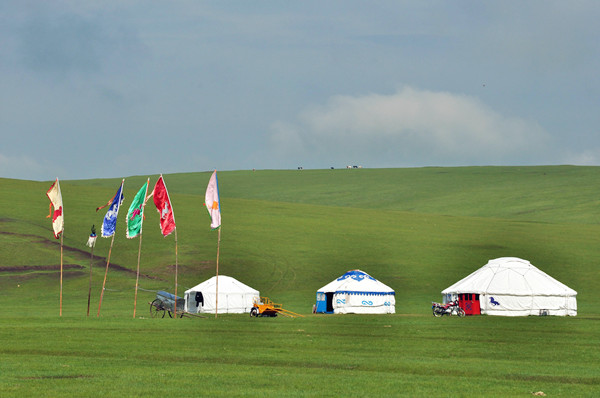Mongolian yurts
 |
The Mongolian Yurt, called "a vaulted tent" or "felt tent" in ancient times, is a domed pealed tent. The yurt frame is a supportive ring consisting of slim wooden poles about two meters long. |
The Mongolian people, who make up a large percentage of the population of Inner Mongolia, have their own social customs and etiquettes that are especially imbued with characteristics of honesty, courtesy and hospitality. When a guest enters the yurt, the housewife presents him or her with a bowl of milk tea with both hands and offers various kinds of dairy products on the table.
The Mongolian Yurt, called "a vaulted tent" or "felt tent" in ancient times, is a domed pealed tent. The yurt frame is a supportive ring consisting of slim wooden poles about two meters long. The wooden poles are fastened with leather thongs and studs to form a fence-like structure called "Hana." The frame is covered with a thick piece of felt fastened from the outside of the yurt with ropes. The felt strip is usually white and decorated with red, blue, yellow cloth. The product is a beautiful yurt with an opening on top which provides both light and ventilation. Generally, a yurt is 10-15 chi high (1 chi=1/3 meter), and its walls span 5 chi. The wooden door usually faces south or southeast. Behind every yurt is a bare stick - Jiebang - belonging to Suwu, an envoy of the Han Dynasty (206 BC-AD 220) who was admired by people for his high morality. The Jiebang, a symbol of power and morality in ancient China, is worshipped by Mongolians and guests are not permitted to approach it.
The emergence of Mongolian yurts is closely related to their nomadic lifestyle. Mongolians move about to seek new water sources and pastures, meaning the yurt meets their lifestyle requirements. Each part of the portable yurt is ingeniously made and can be disassembled, making it both beautiful and practical. Because of its domed structure, there is no worry about accumulating snow or water; the structure can also withstand storms. The thick felt can be adjusted according to the temperature, and the bottom of the felt can be rolled up for ventilation.



 Print
Print Mail
Mail





